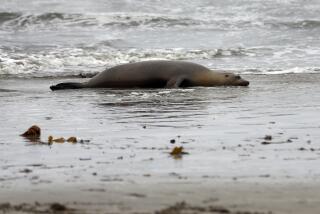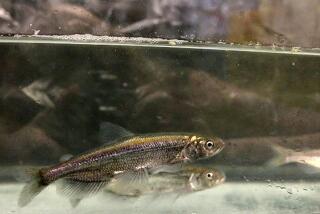Squid Squeeze
- Share via
A commercial fisherman since age 12, Tom Jerkovich now skippers his own million-dollar rig, with three crew members to help haul the catch from a net that spans a quarter-mile.
But for weeks on end over the last few months, Jerkovich’s 67-foot Pacific Leader has sat idle at Berth 73 in the San Pedro harbor, catching nothing but wind. When he has taken the boat out on the ocean, Jerkovich has been reduced to fishing for sardines--”pet food,” he calls it disparagingly, which sells for $80 a ton.
“It barely pays the bills,” the 41-year-old fisherman grouses.
It wasn’t always like this. Jerkovich and others like him up and down the state’s coast normally fish for squid, a popular and pricey commodity that shows up as calamari at seafood restaurants. But the squid have all but disappeared in the wake of El Nino.
The numbers are staggering. By industry and government estimates, the haul of squid in California has dwindled from 100 million pounds last season to virtually nothing this year, as warm coastal temperatures have driven the squid to colder, deeper--and far more unfishable--waters.
Hauls of herring, sea urchin and rockfish also appear to have suffered big drop-offs, and fishing industry leaders call the losses “cataclysmic.”
But help may finally be on its way.
After hearing months of pleas from the industry, the Governor’s Office of Emergency Services in Sacramento is now asking the federal government to declare an economic disaster in the state’s fishing trade.
In a letter sent to the U.S. Small Business Administration on Friday, the state said businesses in 17 counties--including all 15 on the coast--have been hurt by the phenomenon and should be made eligible for low-interest loans of as much as $1.5 million each to help them.
“It really has affected California border to border,” Nancy Ward, emergency services’ deputy state coordinating officer, said in an interview.
Small-business administrators in Washington, D.C., will begin looking at the request immediately. Agency spokesman Rick Jenkins said, “It’s a fair bet, depending on the data,” that disaster assistance will be approved, perhaps within the next few days.
“This is certainly good news,” Zeke Grader, executive director of the San Francisco-based Pacific Coast Federation of Fishermen’s Associations, said when told of the request. “We didn’t get any response [from officials in Sacramento] originally, and there’s been a certain amount of frustration, but I’m happy that at least they’re acting now.”
For sportfishers, an increase in coastal water temperatures of up to six degrees because of El Nino has meant an abundance of exotic species such as yellowtail and bluefin tuna in some areas. But it has been a very different story for the commercial fishing fleet.
California’s coastal waters are home to the fourth-biggest commercial fishing industry in the nation, worth more than $800 million a year, according to officials with the California Seafood Council in Santa Barbara.
Commercial Growth
In the last few years, squid has become the biggest single staple in the commercial fishing diet, growing from 19 million pounds caught in 1989 to an estimated 156 million pounds last year. The squid, selling for about $300 per ton, has attracted dozens of Washington state fishers to local waters, particularly off Ventura and San Pedro.
The tremendous growth has fueled tensions between local and out-of-state squid fishers, and some worry that the white, 8-inch long mollusks caught in California waters are being overfished, threatening their long-term prospects. But Doyle Hanan, senior marine biologist with the state Department of Fish and Game, said their recent disappearance from fishing waters is simply a reflection of the migration caused by El Nino.
“The squid resources are in good condition. They’re avoiding the warm water, either by going deeper or going north,” said Hanan, who is leading a new three-year state study on the squid and how best to regulate their harvest.
To finance that study, the state is instituting a $2,500 permit fee for all commercial squid fishers, but many complain that El Nino has made it tough for them to pay for their expenses--much less a pricey new permit.
“El Nino has decimated us,” said Tim Sullivan, a Half Moon Bay fisherman who scours the Channel Islands for squid in winter. A father of five, Sullivan said: “We’re nearly starving to death. . . . Even if you save and plan ahead, it’s hard to prepare for this.”
Last year, Sullivan said he landed 2,000 tons of squid in three months, grossing his boat nearly $450,000. This year, he said, he has caught next to nothing.
Squid fishers up and down the West Coast share similar stories.
‘For Sale’ Signs and Creditors
Several hundred West Coast fishers, working both squid boats and the light boats that illuminate the waters and attract the squid to the surface, have lost their jobs because of plummeting revenues, industry officials estimate. Many of those still working are fishing for much less lucrative catches, such as mackerel and sardines. “For sale” signs have popped up on boats around the state, with some owners accepting drastic discounts.
In Northern California, Monterey County last month declared its local fishing industry in a state of disaster and appealed to the state for help.
State figures show that in December, in the midst of the season, there were only 2,515 pounds of market squid caught in California, compared with nearly 45 million pounds that same month a year before. Although squid supplies from elsewhere around the year should keep calamari on menus, experts say, prices could go up.
Mike McLenaghan, a Seattle resident who runs two squid fishing boats in Southern California waters, figures that he has lost a million dollars in potential earnings this season. He was turned down for a small-business loan last month because the Small Business Administration maintained at the time that fishing losses were not covered by the widespread disaster declarations that followed the El Nino storms in February.
“I have the creditors all over my back,” he said. “I’ve re-mortgaged my house twice because of this, and I can’t do it again.”
In San Pedro, boat owner Pete Russo brought back a load of mackerel the other morning--”just enough to keep the boat running”--but hasn’t caught any of the higher-priced squid in months. “Not a thing,” he said.
Russo says he would be hard-pressed to give away his 87-foot boat these days, with $50,000 in annual insurance costs plus other expenses to cover. “Who’s gonna buy a boat when the fish are this bad? One more year like this and we’ll all be out of business,” he said.
El Nino has hit the commercial fishing industry hard before--most notably in 1982-83--but Jerkovich in San Pedro says: “This one’s actually worse. It seems longer, more intense.
“But what can you do?” he said after he and his men had finished unloading 60 tons of sardines from an all-night fishing expedition.
“You adapt. Things that are broken, you just patch. And you hope that it gets better.”
Times correspondent Lisa Fernandez contributed to this story.
More to Read
Sign up for Essential California
The most important California stories and recommendations in your inbox every morning.
You may occasionally receive promotional content from the Los Angeles Times.










